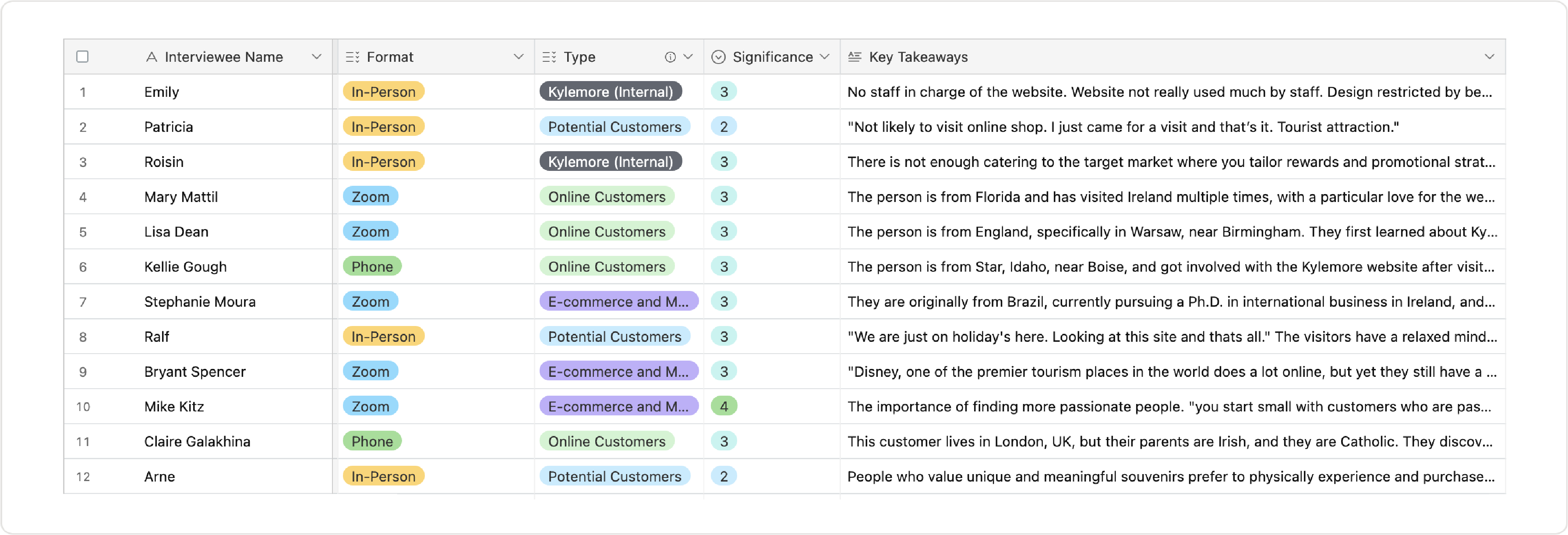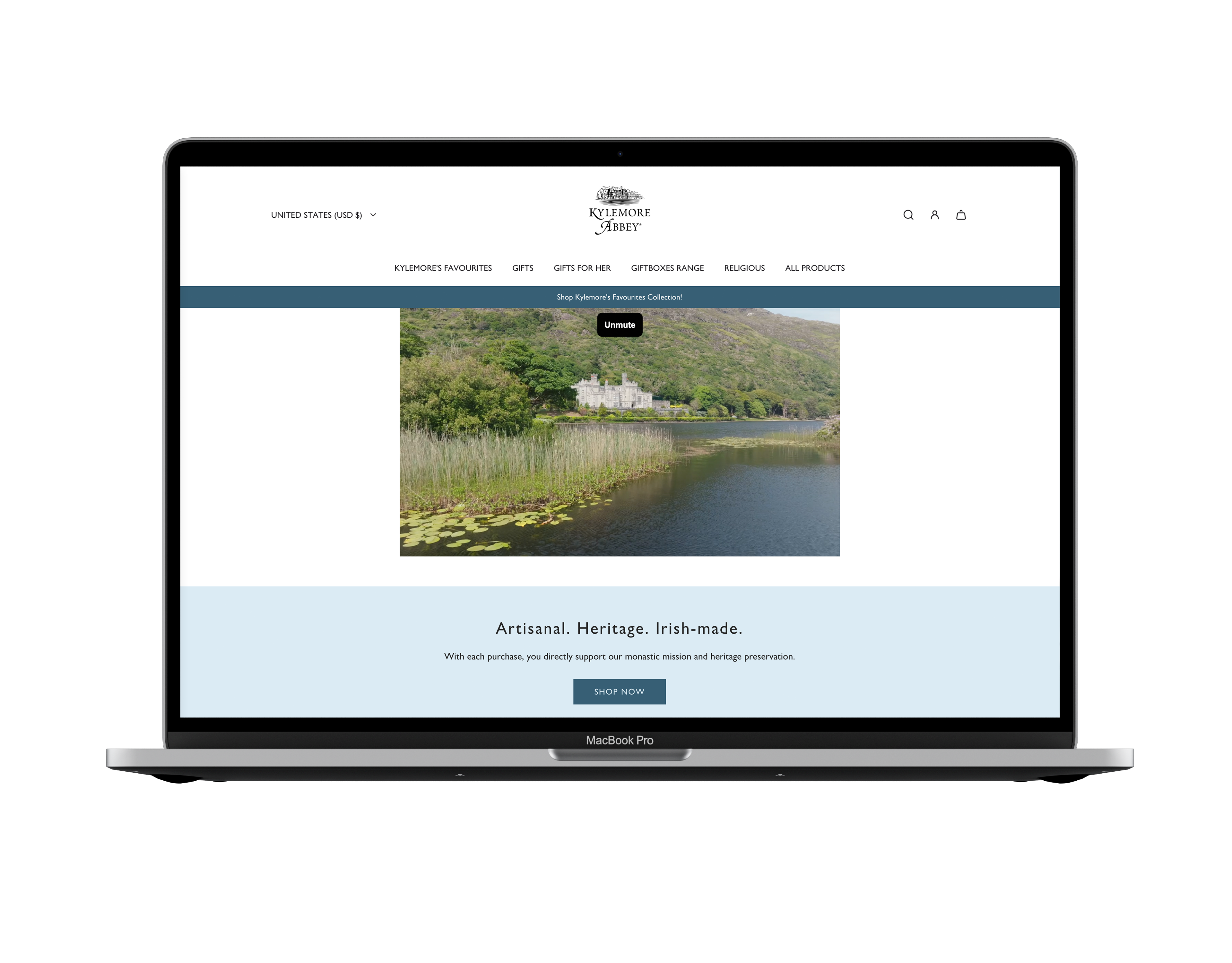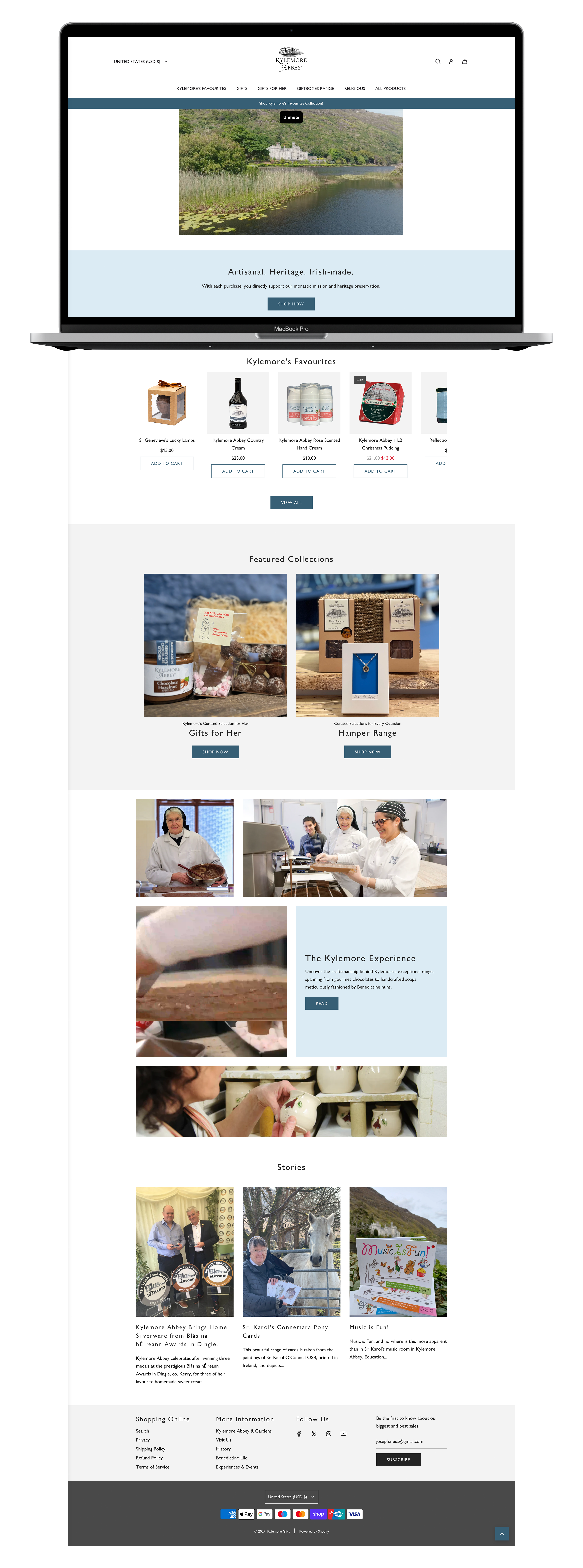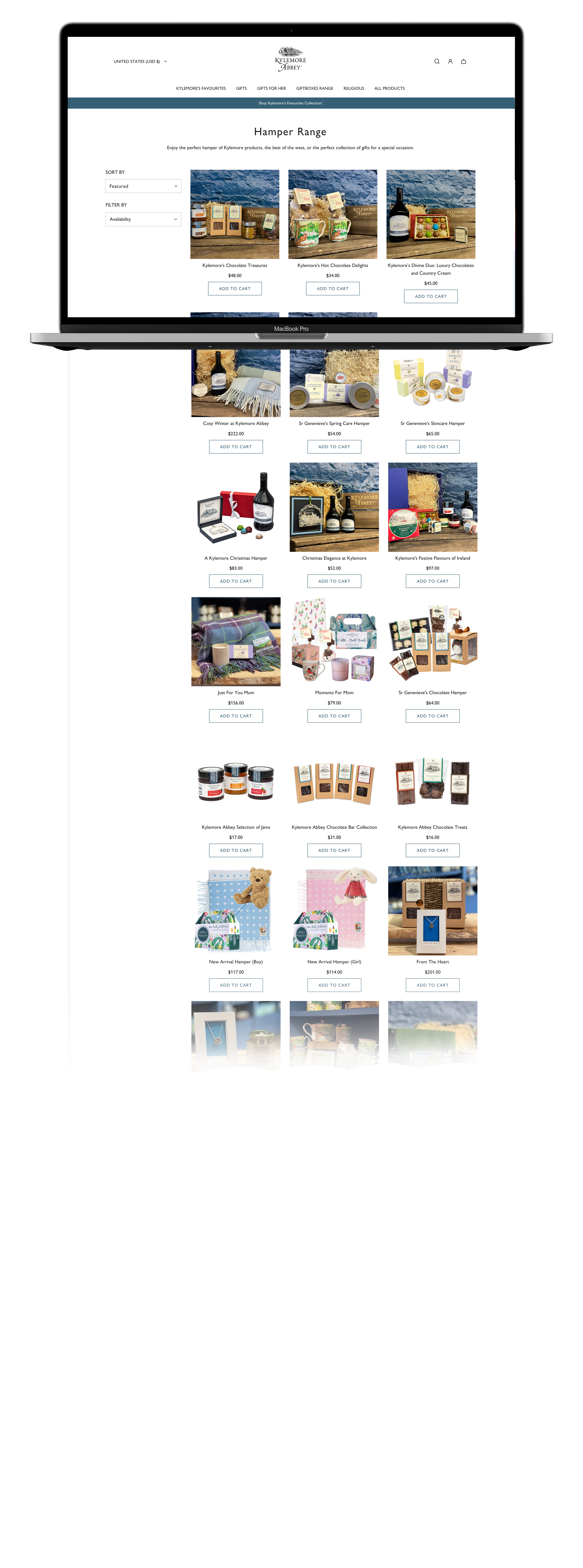Nestled in the heart of Connemara, on the Wild Atlantic Way, Kylemore Abbey is a haven of history, beauty, and serenity. For the past century, Kylemore Abbey has been the cherished home of a Benedictine order of Nuns. This enchanting sanctuary opens its doors to visitors from across the globe, inviting them to immerse themselves in the captivating charm of its sprawling 1,000-acre estate.
Historically, Kylemore Abbey had aspired to ‘Bring the World to Kylemore’. Now, as part of their expansion, they want to ‘Bring Kylemore to the World’. With over a half million visitors each year and a captive global audience, which associates Kylemore with beauty, peace, and quality, Kylemore wants to leverage its brand and expand its retail footprint with a focus on online retail growth.
MY ROLE
UX Designer and Graduate Consultant. Interviewing, design, research, prototyping…
CLIENT
Kylemore Abbey and Gardens Ltd.
TIMELINE
8 months (2023)
TOOLS
Adobe CC, Zoom, Airtable, Figma.
TEAM
1 Designer, 1 Head of Retail, 1 Marketing Manager, and 1 Head of Finance.
OVERVIEW
Why did we start?
The project’s objective is to grow the online retail element of Kylemore Abbey’s business, with a focus on own-brand and locally produced goods, to be sold to a global audience. Kylemore did not have expertise or track-record in this online area.
The benefits of this retail growth will enable Kylemore Abbey to re-invest proceeds for the dual charitable mission of supporting the Monastic Community in Kylemore and of preserving and sharing the Heritage of the Estate with the public.
Before starting the project less than 1% of Kylemore’s sales are online.
Project Outcomes
- Optimizing the user experience as well as the retention rate on the e-commerce site by interviewing stakeholders and validating design solutions.
- Gaining a deeper understanding of customer behavior and preferences, allowing for more effective marketing opportunities and design.
Old Website
THE PROCESS
Researching The Problem Space
To delve into the problem, I spoke with over 50 stakeholders and recorded my notes using airtable. During the summer, I had the opportunity to go to Ireland and have conversations with potential tourist customers on-site and the Kylemore team. The aim was to find opportunities for Kylemore to entice abbey visitors to shop online. Eventually, I shifted my focus to speaking with online customers and e-commerce/marketing experts.


INITIAL RESEARCH
Tourist Interviews
I first began speaking with customers onsite, the main themes that arose were that people had limited inclination for online shopping (of course a lot of visitors were older) and they were in a spontaneous vacation/tourist mindset. During these interviews, participants frequently mentioned terms such as “souvenirs,” “gift shop,” and “tourist attraction.” Visitors were primarily seeking a memorable experience at the Abbey and just did not contemplate purchasing “souvenirs” online or continue purchasing online, which makes it challenging for Kylemore as they want recurring customers.
Therefore, these interviews led me to shift my focus to find the true passionate fans of Kylemore, those who wanted to buy online from Kylemore and try to understand their motivation and potential struggles. Hence the online interviews.
”Not likely to visit online shop. I just came for a visit and that’s it. Tourist attraction.
PatriciaTourist
”No. We will see souvenirs from the shop. Not online. Normally, I would buy souvenirs at the spot.
ArneTourist
”I guess I don’t really think about a gift shop having online commerce. I always think it is in the moment. It is a spontaneous purchase.
KimberlyTourist
”We’ve been here five times. I never looked for the online shop. I suppose I associate it with being on holidays and visiting. I wouldn’t be looking for anything.
PatTourist
INITIAL RESEARCH
Tourist Interviews
With this in mind, I had the opportunity to speak with some marketing and e-commerce industry experts and seek their advice on Kylemore’s problem. A few notable interviews include Pam Didner, an award-winning B2B sales and marketing speaker & consultant; Javi Sanchez, who led e-commerce operations at George Washington’s Mount Vernon estate; and Emer Carr, a UX consultant and web developer at Ki Business and Tech in Galway, Ireland, which empowers sustainable growth for small businesses.
These interviews led me to shift my focus to finding the true passionate fans of Kylemore, those who wanted to buy online from Kylemore, and to try to understand their motivation and potential struggles. This would ultimately help me with segmentation and creating a persona that Kylemore can market towards.
”Tourists have that experience, and then, as you go through it, you reach the Kylemore Estate and finally, the last stop is a gift shop. So people have that experience right on the spot, and as they go through the gift shop, they just finish their experience. Who are the people that usually come on the site? Why do they come?
Pam DidnerAward-winning B2B sales and marketing speaker & consultant.
”Half of the people did not know about our online store. We needed to understand the reasons why they came to the online shop. What are their priorities? Do they come for something educational or is it something they want as a gift? We decluttered our site and tried to incorporate the historical significance of Mount Vernon.
Javi SanchezLead e-commerce operations for the Retail Department at George Washington's Mount Vernon.
”There is a mindset of a lot of people in tourism in Ireland, you're going to get ripped off. The tourist persona is not going to repeatedly buy online. If they're focusing solely on tourists, they're not going to be repeat customers. Who are the true fans of Kylemore Abbey? Who are the ones that are singing their praises. Not a local, hate to tell you. So again, it's looking at who are the people who have actually truly experienced Kylemore. I would say look at Americans.
Emer CarrUX consultant and Web Developer at Ki Business & Tech
INITIAL RESEARCH
Survey Online Customers
A Qualtrics survey of over 250 customers was conducted targeting online customers to identify passionate fans of Kylemore. The survey received responses from various countries, with a majority from Ireland and the U.S. I also conducted interviews with 13 participants, mainly older women from the U.S., UK, and Ireland, who volunteered for the interviews. About 40% of those who answered the survey purchased.

-
The predominant age range from the survey was 55-64, with 65 respondents. The next most common range was 65-74, with 62 responses. This indicates that an older demographic was more interested in and engaged with Kylemore’s products.

-
Out of the 200 responses, I found that looking for gifts for special occasions was the main motivation and reason why people chose to visit the online shop and it became clearer when speaking with customers, customers loved talking about gifting items for the nieces and nephews and what type of gift products they would want to see from Kylemore.

-
Another insight that was brought up from the survey was the importance of stories when purchasing. When speaking with customers, customers were enthusiastic about discussing more about Kylemore itself apart from other tourist attractions or shops.
This point was reinforced in my interviews with e-commerce experts as they believed in leveraging the power of brand and heritage. Kylemore Abbey possesses a unique and powerful brand with a rich heritage and history that can be different in the e-commerce space.

-
However, a large glooming issue presented itself when speaking with these customers and when receiving feedback from the survey. And that is shipping. Shipping was found to be the most repeated word when asked what made a customer decide not to purchase something with 125 responses. Kylemore’s shipping price to the U.S. is 50 and when asking U.S. customers what they expect the shopping to be it averaged around 28 dollars.
SYNTHESIZING RESEARCH
Online Customer Insights

SYNTHESIZING RESEARCH
Insights From Website Interactions
Other changes that were implemented in the final site design are also supported by user experience website interaction tools like HotJar. Initiated in September, HotJar recorded over 6,700 user sessions and highlighted important insights and user pain points through the examination of heatmaps, recordings, and movement maps.

IDEATE
Site Map and User Flow
I created a site map and user flow, outlining the steps and various touch points a customer encounters when ordering a product, such as soap. This helped visualize the entire journey, from initial browsing to completing a purchase.

IDEATE
Low Fidelity Wireframes
I then created low-fidelity sketches and interactive prototypes that focused on the site’s functionality and user flows. By presenting these early wireframes to stakeholders like online shoppers, I was able to gather valuable feedback and refine the website’s main features and interactions. As the wireframes progressed, I also increased their fidelity to create more detailed designs that were used as a blueprint for the final product.

IDEATE
Style Guide
Additionally, I created multiple style guide design options and presented them as mood boards to the stakeholders. After receiving feedback, I narrowed down the design direction and created detailed design mockups that showcased the site’s layout, color scheme, and typography. This process allowed me to establish a comprehensive design style guide that the team could continue using after the project.
I worked closely with the marketing team to ensure the visual design aligned with their branding strategy.

FINAL DESIGN


HOMEPAGE AND PRODUCT COLLECTION PAGE EXAMPLE


CONTENT SHIFT EXAMPLE


REFLECTION
After synthesizing my insights and data, I redesigned Kylemore’s Shopify store to better showcase its value proposition to both new and existing audiences. You can view the new site here https://kylemoreabbey.shop/ The changes I recommended are based on gathered data, including curating the site for gift shoppers, leveraging the brand’s heritage by engaging with stories, and reducing shipping costs. My goal was to create a more modern and refreshed feel. Some changes include adding video and image content to highlight the behind-the-scenes process.
IMPACT
Given that this new website launch was recent, in early March, changes like these resulted in a notable 25% increase in the returning customer rate, as well as a 30% increase in total sales thus far. This decision was based on data and a willingness to find a solution that balanced their preferences with the needs of our users.
LEARNINGS
01
CUSTOMER-CENTRIC
I learned the value of deep user research in uncovering key motivations. By identifying gift-giving as the main driver for online purchases, he was able to shape more effective design and marketing strategies.
02
LEVERAGING BRAND
I discovered that Kylemore’s rich heritage was a key differentiator. Highlighting its unique story helped create a deeper emotional connection with customers.
03
ACCESSIBILITY
With many senior users, I prioritized accessible design by using bold, clear components that met WCAG standards, improving the user experience.

